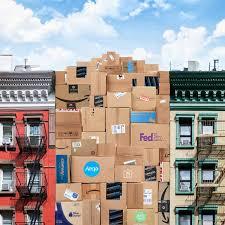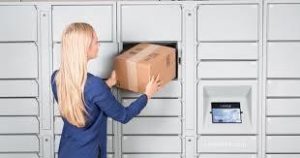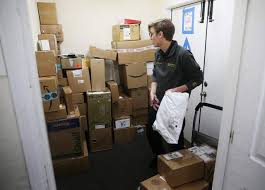 November 2020
November 2020
A tsunami of packages is coming your way. New York City is dealing with the leading edge of this growing wave. Toronto is expecting to be similarly overwhelmed. Is your community prepared?
Toronto, like New York City, loves the convenience of internet shopping. Ordering online and having things delivered to us at home is particularly valuable to those who have difficulty getting to retail stores including older and disabled individuals. This is a new way of buying goods and services for which our infrastructure was never designed. We suffer with increased truck traffic, congestion and air pollution caused by the way we choose to make purchases.
Trying to keep up with the increasing number of packages arriving at high-rise buildings is a losing battle. Building employees, struggling to perform a function not planned for, spend an inordinate amount of time receiving, storing and retrieving parcels with limited space and concerns over losing parcels; in the process, they trade off doing other jobs requiring their attention.
Once that order has been placed online many things happen in the two to four days it typically takes for most deliveries to appear in your building or suite.
In New York City more than 1.5 million packages are delivered daily. The cost of this shows up in growing gridlock, roadway safety and pollution. There isn’t enough legal parking space and loading zones for all the delivery trucks forcing vehicles to double-park on streets. They block bus and bike lanes. In 2018 UPS and FedEx received over 471,000 parking violations; a 34 percent increase from 2013. Highway driving speeds have slowed from 48 km/h to 37 km/h on George Washington Bridge, the most congested interchange in the USA, during this period. Driving through the busiest parts of Manhattan was at an average speed of 11 km/h in 2018.
Logistic centers, once located outside the city, are now being built in or near residential neighbourhoods. There are insufficient locations for trucks to load and unload.
 More deliveries are made to households than businesses. Residential neighbourhoods deal with trucks blocking bike lanes, sidewalks, driveways and crosswalks. Delivery services resort to stacking and sorting packages on sidewalks. Parking violations have become an accepted cost of doing business. Towed vehicles are quickly replaced with another.
More deliveries are made to households than businesses. Residential neighbourhoods deal with trucks blocking bike lanes, sidewalks, driveways and crosswalks. Delivery services resort to stacking and sorting packages on sidewalks. Parking violations have become an accepted cost of doing business. Towed vehicles are quickly replaced with another.
There just isn’t enough room for all the trucks needed to make deliveries along with people and automobiles.
Greenhouse gas emissions are rising.
Things are expected to get worse. Retail transactions made online are only 10 percent (pre-COVID) of all retail transactions. With Amazon moving to one-day deliveries their volume is expected to grow. More are ordering perishables and clothing.
How Cities Cope
Cities are rethinking how existing streets and infrastructure can be better utilized to facilitate increased package deliveries. More deliveries occur evenings and weekends. At night packages are delivered from a larger warehouse to a smaller one closer to the final destination. In Paris electric vans and bicycles are used for deliveries. Convenience stores and flower shops serve as pickup locations. In Hamburg containers with packages are delivered to a drop-off location for delivery by electric tricycle to homes. New York City has about 500 companies, including grocery stores and pharmacies, delivering packages between 7 p.m. and 6 a.m. when streets are quieter. Curbside parking has been turned into temporary loading zones in an effort to reduce double-parking.
The Last Mile
The last mile of delivery is hardest and most expensive. All delivery services are seeking more efficient solutions.
Amazon is testing drones for deliveries of less than 2.3 kilograms in less urban areas and electric delivery vans. Electric cargo bikes are being tested in Montreal and Vancouver for deliveries of up to 350 kilograms. These shorter-range delivery solutions require local consolidation hubs where larger trucks can transfer packages to smaller vehicles. In Montreal a former bus depot has been turned into a local consolidation hub used by five courier companies.
The Vertical Challenge
 The cost of managing package deliveries, rarely considered by residents who generally think only of the minute or two spent retrieving a package, is of great concern to condo directors.
The cost of managing package deliveries, rarely considered by residents who generally think only of the minute or two spent retrieving a package, is of great concern to condo directors.
Most high-rise buildings were never designed to accommodate resident deliveries other than envelopes and the occasional package. Today buildings are inundated with packages, some receiving hundreds each day with volumes tripling as Christmas nears. Packages spill out from behind desks and secure rooms making them accessible to anyone passing by. Each package must be checked in, stored, and a resident informed of its arrival. Packages take up valuable space until someone arrives to pick them up. Residents complain when a package fails to arrive or is misdelivered. Concierge/security now spends a considerable part of the day dealing with packages rather than focusing on their duties.
 There is a high cost for receiving and managing package deliveries. The financial cost is estimated at $20,000 to $50,000 per building per year. Condo management software incorporates technologies that better manage this growing volume of package deliveries.
There is a high cost for receiving and managing package deliveries. The financial cost is estimated at $20,000 to $50,000 per building per year. Condo management software incorporates technologies that better manage this growing volume of package deliveries.
Some communities are seeking to separate themselves from the delivery of packages. Options include setting up smart parcel lockers; reliable, easy to use self-serve machines that allow for the automated deposit and pickup of parcels without involving concierge/security. Others refuse deliveries or require they be delivered to a resident’s door. Carriers may resort to leaving a notice on mailboxes requiring that residents call to arrange delivery. Stickers frequently fall off or disappear. Concierge staff and building management, once relieved of the responsibility to accept, store and retrieve packages for residents, and inform when packages have arrived are better able to focus on the duties for which they are hired.
The volume of package deliveries is expected to continue growing. Avoiding increasing costs and security concerns may depend on finding a workable solution.







